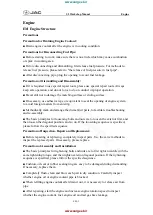
4-5. Operating other driving systems
202
WARINING
◼
Due to the blind zone of the sensor, pay attention to low and small obstacles, and
the corners and sides of the vehicle during parking.
◼
For specific limitations of the sensor, please refer to the relevant description of
the parking sensor.
◼
Pay attention to whether there is enough space when parking.
◼
There is a delay in the parking brake, so the driver should make a judgment in
advance and stop the vehicle if the danger is found.
◼
Please pay special attention to people, animals and various obstacles around the
vehicle, where the sensor has a blind spot that cannot be detected.
◼
When searching for a parking space or during parking, please be aware that there
are no obstacles in the parking space, such as rocks, thin poles or tow bars, as
the system may not detect such obstacles.
◼
The system may not recognize the surface or structure of certain objects (e.g.,
wire fences, fluffy snow, angular pillar, etc.). Therefore, please re-check that there
is enough space in the parking space and surroundings before parking the
vehicle.
◼
If the Park Distance Control (PDC) detects an obstacle, the obstacle may
disappear from the sensor detection range after the car approaches (this is highly
likely to happen when detecting obstacles that are too high and too low), thus not
detecting these items. Do not ignore the warning from the radar warning system,
otherwise the vehicle may be at risk of collision.
◼
Due to the influence from various external sound and electromagnetic fields (e.g.
other vehicles using ultrasonic ranging, air pressure, engine noise, electric gears,
induction loops, etc.), the system cannot achieve absolute immunity to
interference.
◼
The immunity to interference and detection performance of ultrasonic ranging
systems may be reduced by environmental conditions and obstacle reflection
properties, which are determined by the physical properties of ultrasonic
propagation.
◼
The installation position of the sensor has an important impact on the system
performance, which is reflected in the reflection from the vehicle bumper surface
itself, ground echo reflection and detection range.
◼
Avoid cleaning the sensor with a pressure washer or steam cleaner to prevent
damaging the sensor. When cleaning the vehicle, you should use a smaller water
flow to rinse the sensor surface for a short time and keep at least 10 cm away.
◼
The propagation of sound waves in air is based on the physical properties of
refraction and diffraction phenomena. Temperature differences in the air are one
of the most important factors in generating a non-uniform propagation medium,
which in turn leads to acoustic diffraction.
◼
The detection performance of ultrasonic detection equipment can be affected by
the following factors.
⚫
Hot vehicle exhaust.
⚫
High temperature tarmac.
⚫
Summer breeze.
⚫
Temperature stratification.
Summary of Contents for E-HS9
Page 2: ......
Page 20: ...18 ...
Page 65: ...1 3 Immobilizer system 63 Safety precautions 1 ...
Page 211: ...4 6 Driving information 209 Driving 4 ...
Page 305: ...6 4 Other in car equipment 303 In car equipment 6 ...
Page 341: ...7 3 Self maintenance 339 Service and maintenance 7 ...
Page 388: ...9 1 Specification Service data 386 List of abbreviations 386 Other information 385 ...
Page 391: ...389 Charging station references Hood opening handle Charging port cover Tire pressure ...
















































